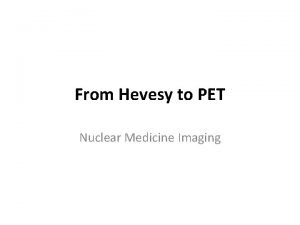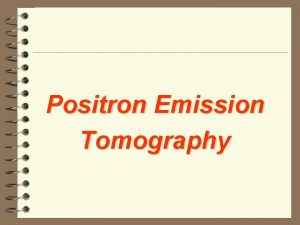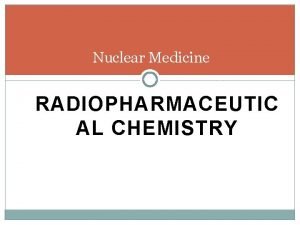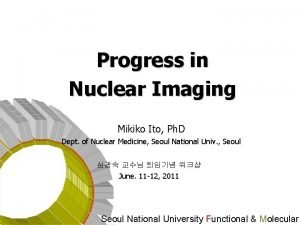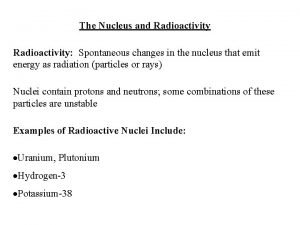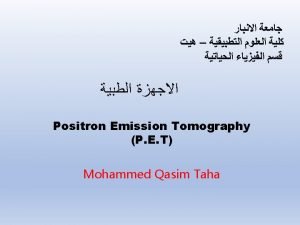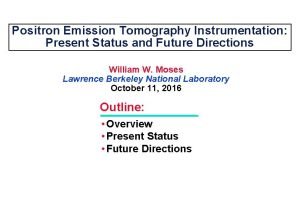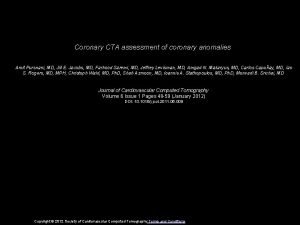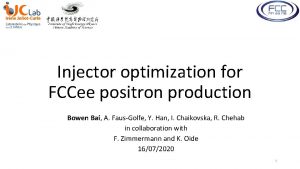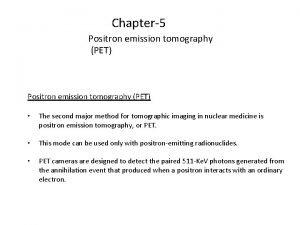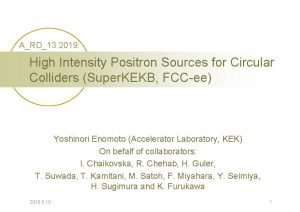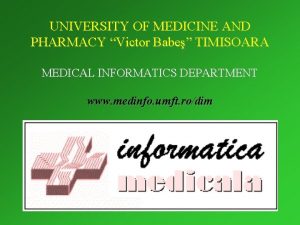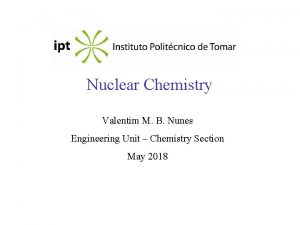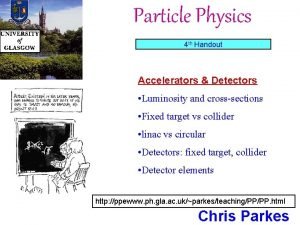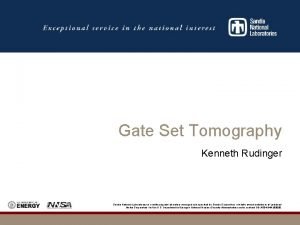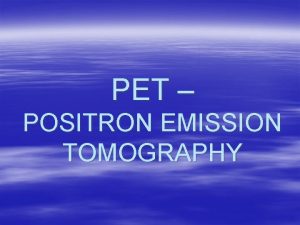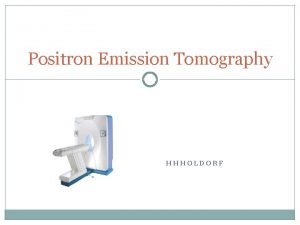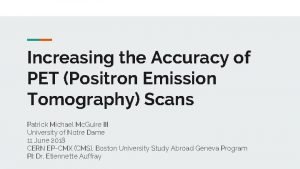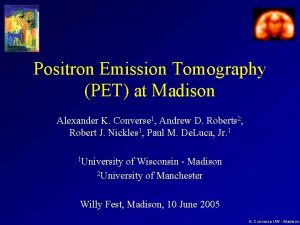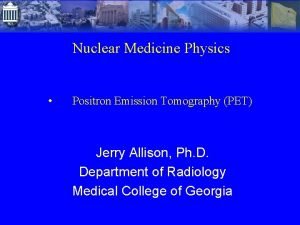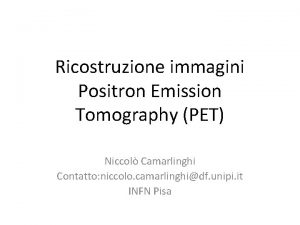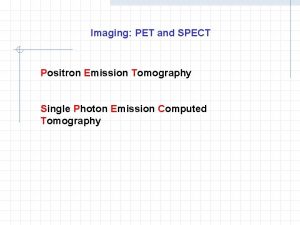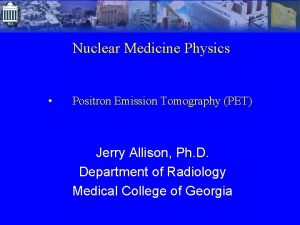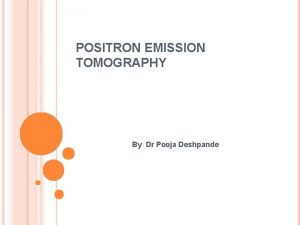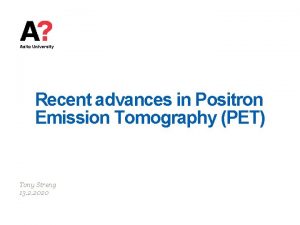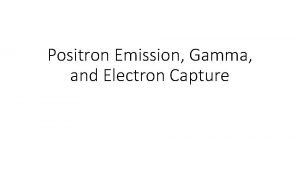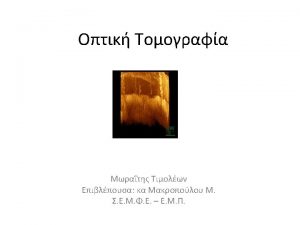Chapter5 Positron emission tomography PET The second major
















- Slides: 16

Chapter-5 Positron emission tomography (PET) • The second major method for tomographic imaging in nuclear medicine is positron emission tomography, or PET. • This mode can be used only with positron-emitting radionuclides. • PET cameras are designed to detect the paired 511 -Ke. V photons generated from the annihilation event that produced when a positron interacts with an ordinary electron.

Chapter-5 Positron emission tomography (PET) • Following emission, any positron travels only a short distance before colliding with electrons in surrounding matter. • The paired 511 -Ke. V annihilation photons travel in opposite directions (180 apart) along the line. • Following the acquisition of the image of positron emissions, the data are reconstructed in a manner similar to that used for SPECT

Chapter-5 Positron emission tomography (PET) Why PET ?

Chapter-5 Positron emission tomography (PET) Basic principles of annihilation coincidence detection • When a positron undergoes annihilation with a negative electron, their rest masses are converted into pair of annihilation photons.

Chapter-5 Positron emission tomography (PET) Basic principles of annihilation coincidence detection • The photons have identical energies (511 Ke. V) and are emitted simultaneously, in 180 -degree opposing directions, usually within a few tenths of a mm to a few mm of the location where the positron was emitted, depending on the energy and range of the positrons.

Chapter-5 Positron emission tomography (PET) Basic principles of annihilation coincidence detection • Simultaneous detection of two annihilation photons allows PET to localize their origin along a line between the two detectors, without the use of absorptive collimators. This mechanism is called annihilation coincidence detection (ACD) • The ability of ACD to localize events on the basic of coincidence timing, without the need for absorptive collimation, is referred to a electronic collimation

Chapter-5 Positron emission tomography (PET) Basic principles of annihilation coincidence detection • Coincidence logic is employed to analyze the signals from the opposing detectors. • For many PET scanners, this is accomplished by having the electronics attach a digital “time stamp” to the record for each detected event. • The coincidence processor examines the time stamp for each event in comparison to events recorded in the opposing detectors. • A coincidence event is assumed to have occurred when a pair of events are recorded within a specified coincidence timing window , which typically is 6 -12 nanoseconds.

Chapter-5 Positron emission tomography (PET) Basic principles of annihilation coincidence detection • Although annihilation photons are emitted simultaneously, a small but finite coincidence window width is needed to allow for differences in signal transit times through the cables and electronics, as well as different distance of travel by the two photons from the annihilation event to the detectors. • The need for a finite window width permits other types of events to occur in coincidence (will be discussed later) • The annihilation photons are not always emitted in precise back-to-back directions

Chapter-5 Positron emission tomography (PET) Event types in annihilation coincidence detection • ACD produces an output whenever two events are recorded within specified coincidence timing window. • Generally, any such events are called prompt coincidences (coincidences)

Chapter-5 Positron emission tomography (PET) Event types is annihilation coincidence detection • True event The coincidence arise from a pair of photons produced from the same annihilation event and that the annihilation event occurs somewhere within the coincidence line between the detectors. Theses events are called true coincidence

Chapter-5 Positron emission tomography (PET) Event types is annihilation coincidence detection Other prompt coincidence events also can occur within the resolving time of the detector system 1. Random coincidence (also called accidental coincidence) Occur when annihilation photons from two unrelated positron annihilation events are detected in two different detectors, within the coincidence timing window, and recorded as a single coincidence event. This can happen if one photon from each annihilation event is detected in each detector element.

Chapter-5 Positron emission tomography (PET) Event types is annihilation coincidence detection Other prompt coincidence events also can occur within the resolving time of the detector system 1. Random coincidence (also called accidental coincidence)

Chapter-5 Positron emission tomography (PET) Event types is annihilation coincidence detection • A second category of non-valid prompt coincidence are scatter coincidence 2. Scatter coincidences • These occur when one (or both) of the photons from an annihilation undergoes scattering and is detected in a detector other than the one that would be appropriate for a true coincidence event.

Chapter-5 Positron emission tomography (PET) Event types is annihilation coincidence detection 3. Single event • The unpaired photon is called single event and is usually rejected • A single event registered when an unpaired photon from a nonannihilation gamma ray impacts a detector • A single event is also registered when only one of a pair of annihilation photons impact a detector; the other photon can leave the plane of detection or it can be absorbed or scattered by the surrounding medium.

Chapter-5 Positron emission tomography (PET) Event types is annihilation coincidence detection 3. Single event • By chance, photons generated simultaneously from separate sites in the body may reach the crystal at the same time. These separate events are incorrectly perceived as though resulting from annihilation of a single positron emission occurring along a line between the two detectors

Chapter-5 Positron emission tomography (PET) Event types is annihilation coincidence detection • Scatter and random events are undesirable because they contribute to an increase in image background counts and consequently cause a reduction in image contrast. • They provide incorrect localization of the positron annihilation event.
 George charles de hevesy
George charles de hevesy Positron emission tomography
Positron emission tomography Positron emission tomography
Positron emission tomography Positron emission tomography
Positron emission tomography Positron emission tomography
Positron emission tomography Gamma emission equation
Gamma emission equation Positron emission
Positron emission Pet/ct
Pet/ct Seismic tomography ______.
Seismic tomography ______. Dr amit pursnani
Dr amit pursnani Positron
Positron Positron symbol
Positron symbol Positron
Positron Radiology timisoara
Radiology timisoara Radiation symbols chemistry
Radiation symbols chemistry Positron vs proton
Positron vs proton Gate set tomography
Gate set tomography
